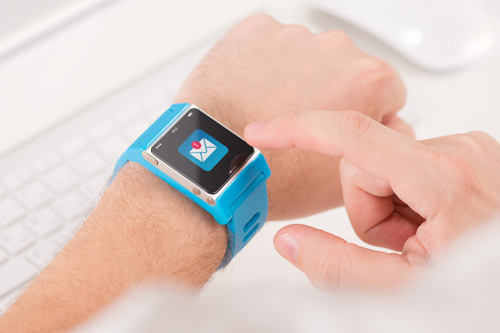It’s hard to ignore all the hype around wearables. It’s an exciting time and it’s easy to understand why. They will give consumers unprecedented levels of access to online content and present another step towards having a truly connected consumer. Digital marketers are getting pretty excited about them too, especially with so much access to data and the perceived opportunities for engaging customers.
The launch of the Apple iWatch and a series of Google smart watches rumoured for release this summer has increased marketer anticipation even more. But history shows that marketers don’t adopt new devices and mediums with much success, so before the industry dives in head first, here is a list of five things every digital marketer should know about these new devices:
- Marketers are running before they’ve learnt to walk
Going back ten years or so, mobile, and then tablet devices, were received by marketers with the same enthusiasm as wearables. And look where the industry is now. Years later and many brands still don’t have a mobile marketing strategy. Or if they do, they are just pushing messages out to devices randomly, with no idea who is viewing them and what their interests are.
The industry needs to take a step back and focus on getting mobile right, and the only way it is going to do that is using data. Unlocking data will allow marketers to enrich the content experience and ensure that anything pushed to the device, and then in the future the wearable, is contextually relevant to that person’s interests.
This will create a better experience for the customer and will ensure higher engagement.
- Wearables are not made for rich content
At the moment, wearables are primarily lifestyle and productivity devices. They’re things like smart watches and Google Glass, which are used for measuring sleep patterns, checking text messages or the weather. They weren’t designed to be used to display rich content, so we shouldn’t consider them to be a traditional advertising medium.
There’s no room for banner ads, and no one will watch videos on those tiny screens, so they require a whole different approach. They’re also designed for use in short, sharp bursts, so the opportunity to deliver a message that sticks is incredibly limited. If content is going to be pushed to a wearable device it will need to be hyper targeted and consider the device, location, time of day, context and a whole load of other variables.
- Are we ready for them?
Sceptics think wearables are a fad and there is some evidence to support this, for example, one-third of U.S. consumers who have bought an activity tracker stopped using it within six months. While this may seem high, history suggests we’ll make it work – just look at the adoption speeds for smartphones despite early scepticism around battery life.
Those closest to the technology industry certainly feel that we’re ready to embrace them. Even looking back a few months, wearables were the darlings of consumer electronics show, CES, with Razer Nabu, LG Lifeband Touch, Sony Core and the newest iteration of Pebble dominating international event write-ups. When wearables do become the norm, the key for marketers will be to find a way to use them to deliver real value, then they’ll be able build longer lasting relationships with their customers over many years.
- They’ll definitely give us more data
One key benefit of wearables will be the granular data they will provide marketers. If data from the smartphone gave marketers a more detailed understanding of their customer’s likes, dislikes and interests, then wearables will supersede this ten-fold. They’ll provide more accurate location data, will give data on what the user is looking at, and some will go as far as giving insights into the user’s mood.
Again, the key for marketers will be to find a way to make the most of this data and turn it into insights that deliver a better customer experience.
- There’s potential in the applications
Businesses normally play second fiddle to consumers when it comes to technology adoption. But wearables seem to be the exception to the rule and the industry is adopting them at an astounding rate. But it’s the software applications, not the in-device messages, that will create better connections in the enterprise and add real value.
Look out for worker productivity apps for wearables across a range of industries in the next few years. Salesforce has recently launched a platform to bring enterprise-focused apps to wearable devices, which shows recognition from one of the industry’s biggest players that wearables will play a key role in the way we collaborate and share in the workplace.






